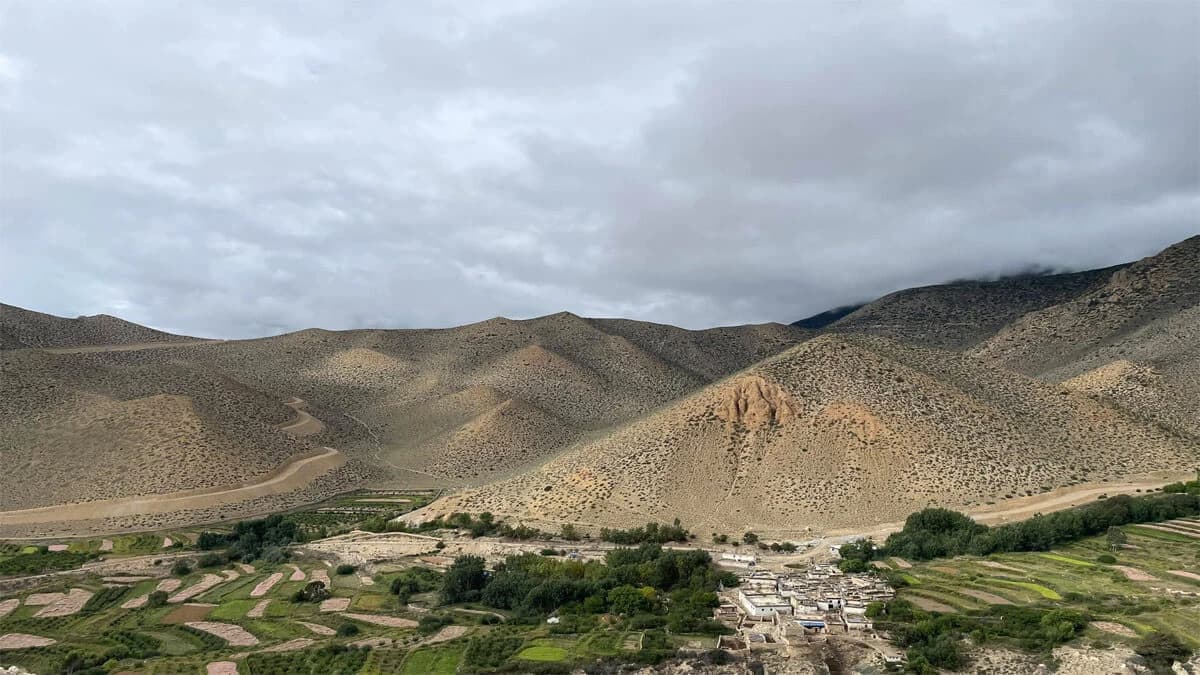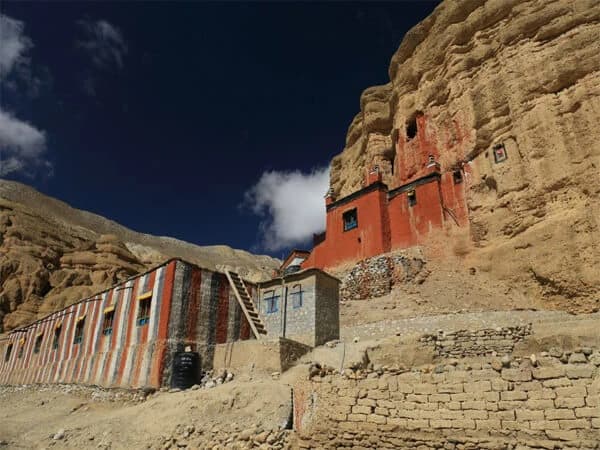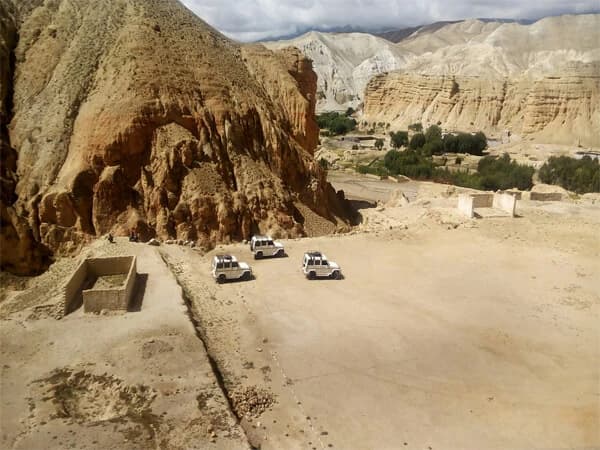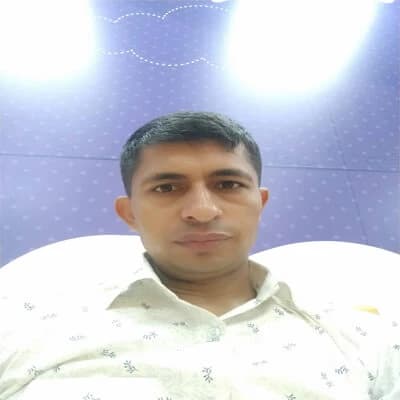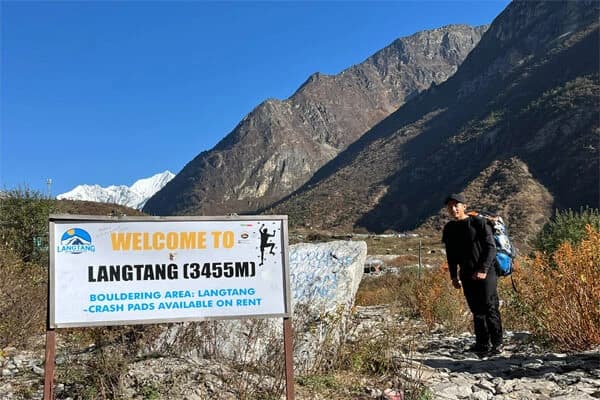The Upper Mustang Tour takes you to a remote and magical land. This high desert area in Nepal's rain shadow region is home to breathtaking scenery, historic caves, and a vibrant Tibetan culture. Trekkers may take in the walled city of Lo Manthang, serene trails, and ancient Buddhist monasteries. It is ideal to travel between May and November and specific permits are required. The area offers profound cultural insights and unspoiled beauty, whether you choose to travel by vehicle or take part in teahouse hiking in Mustang. For those looking for adventure, and a unique Himalayan experience, this is the ideal place.
Exploring Upper Mustang: Nepal’s Hidden Himalayan Kingdom
One of the most unique and unexplored areas in the Himalayas is Upper Mustang. It was restricted to foreigners until 1992 and is frequently referred to as the Forbidden Kingdom of Nepal. Few tourists are still able to visit this isolated region of the nation. Upper Mustang is in the Mustang region in Nepal and reminds one of a time gone by. Here, Tibetan culture is still vibrant and powerful, life moves slowly, and the scenery is colorful and dry.
Its ancient past is where the name "Forbidden Kingdom" originates. Mustang had its own monarchy, royal family, and customs for hundreds of years. As a proud monument of that history, Lo Manthang's walled city still survives today. You will feel a strong connection to a world that few people have seen when you stroll through its winding lanes, see its historic monasteries, and converse with the friendly, hospitable natives.
Even during the rainy season, the Mustang region remains dry due to its unique location behind the Himalayas. Because of this, it's the ideal location for summer hiking. For those seeking a unique experience that is serene, spiritual, and away from the throng, Upper Mustang is undoubtedly Nepal's best-kept Himalayan secret.
Where Is Upper Mustang and Why Visit?
Location of Upper Mustang
Upper Mustang is situated inside the "Annapurna Conservation Area" in northwest Nepal. Even during the monsoon season, it receives very little rain because it is located in the rain shadow of the Annapurna and Dhaulagiri mountain ranges. This makes it one of the top "Nepal remote trekking routes" for summertime travelers who wish to see the high Himalayas. The Upper Mustang was formerly a part of an old trade route that connected Tibet and Nepal.
The area extends from the little village of Kagbeni, which is located north of Jomsom, to the walled city of Lo Manthang, which was once the royal capital. Upper Mustang's distinct location makes it feel more Tibetan than Nepali in terms of both culture and geography.
Why Visit Upper Mustang?
Upper Mustang is worth a visit for a variety of reasons, particularly if you want isolated and culturally diverse experiences. Tibetan Culture in Mustang: The Lobas, who live in Upper Mustang, are Tibetan Buddhists. Tibetan culture has a strong influence on their language, traditions, holidays, and traditional attire. Discover sky caverns cut into cliffs, tour centuries-old monasteries, and observe spiritual customs that haven't changed in many years.
Unique Landscapes: Upper Mustang features dry, desert-like terrain with colorful cliffs, dramatic gorges, and windswept plateaus, in contrast to the verdant slopes found in most of Nepal. Unlike somewhere else in the Himalayas, the landscape is untamed, expansive, and breathtaking.
Less Crowded and Peaceful: Only a few trekkers visit Upper Mustang each year because it is a restricted region that needs special permissions. Because of this, you may enjoy "remote trekking routes" in peace and quiet, free from the throngs that can be found on well-traveled routes like the Annapurna Circuit or Everest Base Camp.
Cultural and Spiritual Journey: Going to Upper Mustang is more than simply a trek; it is a trip back in time. You feel a strong connection to the Himalayan way of life as you stroll through historic villages and talk with the locals.
Whether you go by jeep or on foot, exploring Upper Mustang offers a rare mix of culture, history, and wild Himalayan beauty.
Best time to visit Upper Mustang
In terms of weather, Upper Mustang is a pretty unique location. It is located in what is known as a rain shadow zone, which means that even during the rainy season, it receives relatively little rainfall, in contrast to many other parts of Nepal. Because of its distinct climate, Upper Mustang is among the greatest destinations in Nepal to visit in the summer, when the majority of other trekking routes are muddy, rainy, or even closed because of excessive rain.
Rain Shadow Region of Nepal
The rain shadow region in Nepal describes the regions that are situated behind the towering Himalayan. Some regions are kept dry by these mountains, which prevent the dense monsoon clouds from getting there. One of the most well-known rain shadow areas in the nation is Upper Mustang.
In June, July, and August, areas like Everest and Annapurna receive a lot of rain, while Mustang remains largely dry, dusty, and walking. As a result, Upper Mustang is perfect for monsoon trekking, which makes it the best option for those who wish to avoid the throng and take in the serene mountain scenery in the summer.
Upper Mustang Weather by Season
A brief summary of Upper Mustang's year-round weather is provided below:
- Upper Mustang trek in Spring (March to May): Clear skies, lush blooms, and pleasant weather. Fantastic time for a trip.
- Upper Mustang trek in Summer/Monsoon (June to August): Mustang remains dry, in contrast to much of Nepal. When the rest of the country is wet, it's a great time for individuals who wish to explore.
- Upper Mustang trek in Autumn (September to November): One more perfect season. The vistas are breathtaking, the weather is cool, and the skies are crystal clear.
- Upper Mustang trek in Winter (December to February): quite chilly, with snow in the upper elevations. Trekking becomes challenging as many teahouses close.
Best Time for Festivals and Culture
The Tiji Festival, the most well-known cultural festival, often occurs in May, during the dry spring season. Enjoy the wonderful weather and rich Tibetan Buddhist traditions at this time of year. Therefore, the rain shadow keeps the Upper Mustang weather suitable for trekking for the most of the year, especially during periods when the rest of Nepal is excessively rainy.
How to Get to Upper Mustang: By Jeep or Trek
One of Nepal's most isolated and intriguing locations is Upper Mustang. Even getting there may be an experience. Your time, budget, and degree of fitness will determine whether you opt for a comfy vehicle trip or a foot walk. Let's take a quick look at each choice.
Upper Mustang Jeep Tour – Quick and Scenic
The Upper Mustang jeep trip is a fantastic option if you're short on time or would rather not exert yourself. The trip often begins in Pokhara and passes through the world's deepest gorge, the stunning Kali Gandaki Valley. The jeep next travels to Jomsom before continuing on a dusty yet picturesque road to Lo Manthang, Upper Mustang's walled capital.
You'll go past lovely villages, barren cliffs, and vibrant rock formations. With the jeep tour, you may see important locations like Ghami, Chhusang, and Kagbeni with little to no walking. Even with a little more comfort, you may still take in the area's culture, landscape, and natural beauty.
Families, photographers, and anybody else who wishes to explore Upper Mustang but might not be able to go great distances will find this alternative perfect.
Upper Mustang Trekking – Slow and Immersive
Trekking to Upper Mustang provides a strong sense of connection to the land for those who enjoy hiking and adventure. A quick flight from Pokhara takes you to Jomsom, where the traditional trekking path starts. You will next gradually ascend along the same Kali Gandaki Valley, passing ancient villages, monasteries, and sky caverns.
Mustang Trekking allows you more time to interact with locals, discover undiscovered routes, and experience the area's serenity and spiritual atmosphere. Better altitude acclimation is also made possible by it.
The trek has its own magic, as does the Upper Mustang jeep tour. The jeep tour is ideal if you want to see the area more quickly and comfortably. Trekking, however, is the best option if you're looking for a more immersive experience and a physical challenge.
Upper Mustang Trek Itinerary Overview
One of Nepal's fascinating trekking itineraries is the Upper Mustang trek itinerary. This place is in Nepal's Mustang region, which was formerly referred to as the "Last Forbidden Kingdom" because to its remoteness and restrictions. In contrast to other treks that concentrate on mountain views, it immerses you in a high-altitude desert that is home to centuries-old Mustang caves and monasteries, colorful cliffs, and ancient Buddhist culture.
Starting the Journey: Jomsom to Kagbeni
A picturesque flight from Pokhara to Jomsom starts your adventure. From there, Kagbeni, a traditional settlement that acts as the entryway to Upper Mustang, is where you enter the Mustang area. The scenery changes swiftly, from green slopes to dry, rocky roads surrounded by cliffs.
Trekking Through Remote Villages
Remote communities including Chele, Syangboche, Ghiling, and Ghami are traversed by the trail. These villages provide visitors a genuine glimpse into the lives of the locals and offer simple teahouse accommodations. The landscape grows more desolate and the vistas more bizarre as you hike farther into Mustang. Old monasteries, mud-brick homes, and prayer flags flapping in the breeze are all visible.
Reaching Lo Manthang: The Heart of Upper Mustang
The Upper Mustang trek itinerary's high point is arriving at the historic walled capital, Lo Manthang. This tiny city is teeming with royal palaces, Tibetan-style architecture, and spiritual vitality. On a day off, you can visit neighboring sites like the Chhoser Sky Caves and stunning monasteries.
Optional Extensions and Return Route
On the way back, many hikers decide to stop at holy sites like Muktinath Temple and Ghar Gompa. You may experience the diversity of cultures and religions at these sites, which also offer a spiritual touch. The return route is typically quicker and offers the choice of taking a vehicle from a nearby village or trekking back.
A cultural and historical adventure through one of Nepal's most enigmatic environments, the Upper Mustang trek itinerary provides more than just a climb. It is perfect for those who wish to see a distinctive aspect of Mustang Trek in Nepal.
Permits and Costs for Upper Mustang Travel
Upper Mustang is a restricted area in Nepal, thus if you intend to visit, you will require specific permits. This implies that a government permit and a certified guide are required; you cannot simply travel with a standard trekking pass. Let's examine what you require and the associated expenses.
Upper Mustang Trekking Permit Cost
Restricted Area permission (RAP): The Restricted Area permission (RAP) is the primary permission that is needed. For your trip, this is the most crucial and costly permite.
- For the first ten days, each person must pay USD 500.
- You pay USD 50 for each additional day after ten.
You must go in a company of at least two persons (solo trekking is not permitted), and this permission can only be obtained through a certified trekking agency. Although this may seem pricey, the money spent helps to protect this special area of Nepal and the local culture. It also aids in limiting the number of hikers in this delicate region.
- Annapurna Conservation Area Permit (ACAP) Since Upper Mustang is located inside the Annapurna Conservation Area, you will also require the ACAP.
- Each person must pay NPR 3,000, or around $25 USD.
This is a one-time charge that is good for the duration of your trek. This is a one-time charge that is good for the duration of your hike. The ACAP fee funds trail upkeep, local development, and conservation initiatives. It is employed to safeguard the Annapurna region's animals, uncommon plants, and ecosystem.
Where to Get Upper Mustang Trekking Permits
Your Nepal trekking agency arranges both permits. We will handle all the paperwork if you make your reservation with our agency, Nepal Trekking Routes.
You will require:
- A duplicate of your passport
- Photos the size of a passport
- Details of your visa
A crucial aspect of organizing your trip to Upper Mustang is obtaining the appropriate permissions. Though the Upper Mustang permit cost may be higher than other treks, it’s worth it for the cultural experience, peaceful trails, and untouched beauty you’ll discover.
Cultural Insights: Tibetan Influence and Local Traditions in Mustang

The Upper Mustang region is a living museum of Tibetan culture in Mustang, offering more than just vistas of the mountains and arid cliffs. The people, language, religion, and customs of this region are closely linked to Tibet because it was formerly a component of the old Tibetan empire. The communities have a great history and are serene and calm. The locals follow Buddhist teachings that have been handed down through the generations, dress traditionally, and speak Tibetan dialects.
Tibetan Culture in Mustang
As you walk through Mustang, you'll notice mani walls—stone walls with carved prayers—lining the walkways, prayer flags flapping in the breeze, and chortens, or Buddhist shrines, rising tall next to the trails. This demonstrates the people's profound spirituality. The slow-paced culture has a strong regard for community and the natural world. People live their lives according to the principles of kindness, karma, and harmony. It's like traveling back in time to Mustang, where Tibetan customs are still practiced.
Buddhist Monasteries in Mustang
Seeing the numerous Buddhist monasteries in Mustang is one of the highlights of Upper Mustang. Usually constructed inside small settlements or on hilltops, these gompas (monasteries) are adorned with sacred figures, ancient scriptures, and vibrant murals. The Jampa Lhakhang, Thubchen Gompa, and Ghar Gompa—one of the oldest Tibetan monasteries in Nepal—are a few significant examples. Here, monks conduct rites, chant prayers, and extend a cordial greeting to guests. These sacred areas are peaceful spots to relax, think, and discover more about Mustang's rich spiritual heritage.
Mustang Caves and Monasteries
The ancient sky caves, which are hundreds of man-made caverns carved onto sheer cliff faces, are another distinctive feature of Mustang. Some served as residences or places of burial, while others served as meditation retreats. These caverns are unique locations of mystery and faith because many of them are close to Mustang monasteries. You can gain a deeper understanding of the region's spiritual and historical significance by touring the Mustang caves and monasteries. It's a real blend of human ingenuity, faith, and perseverance in a hard yet stunning environment. Long after the trip is over, you will have a deep appreciation for Upper Mustang culture if you are interested in ancient ways of existence.
Top Places to Visit in Upper Mustang
It's like entering a living museum of Himalayan beauty, culture, and history as you explore Upper Mustang. Some of the more memorable locations to stop along the way are as follows:
Lo Manthang: The Walled city
The center of Upper Mustang is Lo Manthang. The Mustang Kingdom's capital was originally this little, historic walled city. It is like traveling back in time to explore its winding passageways. This area is home to a number of stunning monasteries, prayer wheels, and whitewashed homes. Must-sees include the Royal Palace and Jampa Monastery.
Lo Manthang travel tips:
- To properly explore and acclimate, stay for at least two nights.
- For the best lighting and less crowds, go in the early morning or late afternoon.
Observe local traditions by dressing modestly and getting permission before snapping pictures.
Chhoser Caves: The Cliffside Mystery
The Chhoser Caves are sculpted into tall rocks just outside Lo Manthang. Originally, people used these artificial caverns for storage, meditation, and even living quarters. You can get a peek of an ancient way of life by climbing inside.
Tips:
- Choose a knowledgeable local guide who can narrate the history.
- The ascent can be sandy and steep, so wear appropriate footwear.
Ghar Gompa: The Sacred Monastery
Ghar Gompa is thought to be among Mustang's oldest monasteries. Tibetan Buddhists see great spiritual significance in it. The property feels serene and strong because it is situated in a tranquil valley. In order to pray for blessings for a safe journey, trekkers frequently pause here.
Muktinath Temple: A Holy Pilgrimage Site
For both Buddhists and Hindus, Muktinath Temple is among the holiest sites in Nepal. At 3,800 meters, it is well-known for its 108 water spouts and its eternal natural flame. Many residents think that coming here gives calm and cleanses sins.
Tips:
- Since it's a place of worship, dress modestly.
- Be ready for large crowds, particularly at festivals.
- Give yourself time to appreciate the breathtaking view of the surrounding mountains.
Each of these places adds something unique to your Upper Mustang experience, offering a diverse blend of history, culture, and scenic beauty.
Accommodation and Food in Upper Mustang
Experiencing the distinct way of life in Nepal's isolated areas is just as important as taking in the breathtaking scenery and historic culture of Upper Mustang. Even though the area is remote from the conveniences of the city, teahouse hiking in Mustang provides a genuine experience.
Teahouse Trekking in Upper Mustang
In contrast to treks that involve camping, Upper Mustang provides teahouse lodging along the route. Trekkers can eat, rest, and sleep in these cozy, family-run guesthouses. The majority of teahouses are simple but comfortable, with a dining area where meals are served, a shared bathroom, and a heated bed.
Even while rooms often have double beds with thick covers, it's a good idea to pack a high-quality sleeping bag, particularly during the winter. The allure of Nepal remote trekking routes is that comfort, simplicity, and cultural ties coexist there; do not expect luxury.
Food on the Trail
Upper Mustang serves straightforward, wholesome, and substantial meals. The majority of teahouses serve traditional Nepali dishes like momos, noodle soup (thukpa), Tibetan bread, dal bhat (rice, lentil soup, and veggies), and copious amounts of butter tea or black tea to stay warm.
Ingredients are sourced locally or transported in by mule or jeep, and meals are prepared fresh. Although the menu is smaller in the higher settlements, it is still sufficient to satisfy your needs. Since it can be challenging to adequately keep meat at high elevations, vegetarian options are popular and frequently the best option.
Simple but Heartwarming Hospitality
The staff at these teahouses are very friendly and hospitable, despite the basic amenities. Cold alpine nights are made much cozier by their friendliness. One of the highlights of the trip is spending time with local families and other hikers over the cooking fire.
You may get a unique glimpse of life in one of Nepal's most isolated areas by going teahouse hiking in Mustang. Being a part of the culture, even for a brief period of time, is more important than simply finding a place to stay.
On these isolated trekking routes in Nepal, sleeping in teahouses makes the experience both practical and intimate, whether you're traveling alone or with a guide.
Physical Fitness and Altitude Considerations
Staying Healthy at High Altitude
The Upper Mustang trip raises you to elevations of above 4,200 meters (13,780 feet) in the Himalayas. This implies that it takes time for your body to get used to the thin air. Many hikers experience headaches, shortness of breath, and fatigue more quickly. Although this is typical, it's crucial to move slowly and take frequent breaks.
Altitude Sickness in Upper Mustang
Altitude sickness in Upper Mustang is one of the main hazards on this trek. If your body doesn't adapt to the height appropriately, this could occur. Headache, nausea, difficulty sleeping, and lightheadedness are early symptoms. It's better to rest and cease rising higher if symptoms worsen, or even descend to a lower location. Avoiding alcohol, eating healthily, and drinking lots of water can all be beneficial. If you feel ill, always let your guide know. They are prepared to assist in these circumstances.
How Fit Should You Be?
Although some preparation is helpful, you don't have to be an athlete to visit the Forbidden Kingdom of Nepal. Carry a light bag, practice climbing hills, and take regular walks prior to your vacation. Strong legs are crucial, but so are good trekking shoes and a strong will.
Acclimatization and Rest Days

Acclimatization days—special rest days where you remain in one location to allow your body to adjust to the altitude—should be on your agenda. Even if you're feeling well, don't skip these days. Even if you're feeling well, don't skip these days.
Despite being windy and dry, Upper Mustang is one of Nepal's most serene and lovely locations. You can experience the magic of this ancient Forbidden Kingdom Nepal without experiencing any health issues if you take the correct precautions and go at the right pace. Take it gently, pay attention to your body, and trek wisely.
What to Pack for the Upper Mustang Trek?
Planning a trek to the Mustang region in Nepal requires careful packing. Even during the warmer months, it can get chilly in this arid and windy region. It's vital to be ready for a variety of weather situations because the Upper Mustang weather can vary quickly, including sunny mornings, cool evenings, and sporadic dust storms.
Clothes for Variable Weather
- Wearing layers is essential. Pack warm layers for the evening and light tees for the day.
- A quality down jacket is essential, particularly on chilly evenings.
- Wearing a garment that is both waterproof and windproof helps shield you from sudden rain and high gusts.
- Bring a wool cap, thick gloves, and thermal base layers.
- The sun is strong at high elevations, you also need sunscreen, sunglasses, and a sun cap.
Footwear and Trekking Gear
- For rocky trails, use hiking boots that are durable and well-worn.
- Bring comfortable footwear and spare socks so you may rest in teahouses.
- A reusable water bottle, a daypack, and trekking poles are also helpful.
Useful Extras
- Keep toilet paper, wet wipes, a power bank, and some snacks with you.
- For dry circumstances, a moisturizer, lip balm, and first aid kit are helpful.
- There are no ATMs in Upper Mustang. Always have your permits, passport, and extra cash on hand.
Your trip in the Mustang region will be more pleasurable and stress-free if you pack carefully. No matter what the Upper Mustang weather delivers, you can explore this incredible location in comfort if you have the appropriate clothing and equipment.
Responsible Travel and Conservation in Mustang
Upper Mustang is a unique location. It receives extremely little rain because it is located in the rain shadow region Nepal. Though vulnerable, the distinctive culture and arid landscape are stunning. You may contribute to its protection as a traveler.
Respect the local culture. Mustang is home to sacred sites, sky caverns, and historic Buddhist monasteries. When visiting monasteries or residences, dress modestly, inquire before taking pictures, and observe local traditions.
Avoid plastic waste. Refill your reusable water bottle at teahouses along the route. If you want to take out your trash, bring a little bag. Every little step counts.
Support the local economy. Selecting teahouse trekking in Mustang enables you to stay and dine at lodges that are owned by families. Employing local porters and guides allows you to gain authentic insights into their way of life while also giving back to the community. Upper Mustang is a sacred and uncommon location. By traveling sensibly, we can preserve it for coming generations.
Final Tips for a Memorable Upper Mustang Adventure
Have an open mind and a flexible attitude if you want to appreciate Upper Mustang to the fullest. The trek can be dusty and the roads can be tough, but the rewards are enormous.
Take it slow. This is an opportunity to interact with people and places, not simply a walk. Enjoy the quiet of the high desert, visit Buddhist monasteries in Mustang, and discover the native way of life.
Plan ahead but stay flexible. Your path may change according to weather, altitude, or road conditions. It's alright, every change offers a fresh experience.
Select teahouse trekking in Mustang if you want to be both comfortable and cultural. Every night is made more special by the warm mattresses, regional cuisine, and welcoming hosts.
Beyond just mountains, this serene rain shadow region of Nepal offers calm, history, and a slowly disappearing way of life. Respectfully arrive, and you'll depart with priceless memories.
Some of Frequently Asked Question
Do I need a visa to visit Upper Mustang?
Yes, a Nepal tourist visa is required for all foreign visitors (with the exception of Indian nationals). You can obtain one online or at the airport in Kathmandu before your trip.
Is a special permit required for Upper Mustang?
Indeed. Because Upper Mustang is a restricted area, you will require both an Annapurna Conservation Area Permit (ACAP) and a Restricted Area Permit (RAP). A certified guide and at least one partner are required for your trip.
How do I get to Upper Mustang?
The majority of travelers take a plane from Kathmandu to Pokhara, after which they either take another flight or a jeep to Jomsom. You can hike or drive deeper into Upper Mustang from there.
Can I reach Upper Mustang by road?
The road up to Lo Manthang is indeed there, but it can be difficult. For a more profound experience, many people like trekking.
Are flights to Jomsom reliable?
Delays are frequent since flights are brief yet weather-dependent. Make a flexible timetable.
Conclusion: Exploring Upper Mustang
Exploring Upper Mustang is like stepping into a world untouched by time. Every stage of the tour offers something magical, from the serene paths and colorful cliffs of the rain shadow region of Nepal to the revered Buddhist monasteries in Mustang and historic sky caverns. The area's natural beauty and rich cultural heritage will make an impression whether you choose to travel by jeep or on foot.
Teahouse trekking in Mustang offers you the opportunity to spend time with local families, experience their warm and simple hospitality, and feel a genuine connection to this enchanted place. Upper Mustang is calm, empty, and brimming with spiritual energy, all of which contribute to its allure as a protected region.
This is more than simply a journey; it's an opportunity to support the future of a live Himalayan culture, travel with awareness, and learn from it. Upper Mustang is a memorable place for anyone who are looking for adventure, depth, and quiet.

